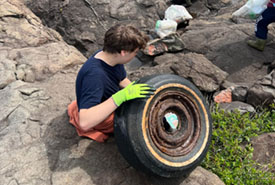People power in creating a thriving world with nature

Conservation Volunteer at Ethier Sandhill, MB (Photo by Lil Creek Photo & Video)
Conservation Volunteers are fuelling restoration efforts coast to coast.
Once the Nature Conservancy of Canada (NCC) conserves a natural area, there may be areas that need some CARE to return them to a connected, adequate, representative and effective ecosystem. Restoration activities, like planting native plants and removing invasive ones, cleaning up debris and rehabilitating altered natural features, can help ensure the landscapes under our care are thriving and resilient. This work can take years of effort and a lot of elbow grease. One pair of hands can only do so much, but as the saying goes, many hands make light work. Each year, our Conservation Volunteers play a vital role in restoring diverse ecosystems across Canada. The impact of our Conservation Volunteers is a testament to the power of collective action. Not only do they help NCC staff accomplish the work we simply couldn’t do alone, but our volunteers also inspire and empower communities to forge a deeper connection with nature. Thank you to all our Conservation Volunteers for their invaluable support in creating a thriving world with nature.
Alberta
Adopt a patch: 8,867 square metres of weed patches targeted to prevent them from becoming larger and more difficult to control

Conservation Volunteer weeding at Golden Ranches, AB (Photo by NCC)
If you’ve ever spent time trying to rid your garden of weeds, you know what it takes hard work and perseverance. Now imagine trying to weed property 100 times that size! That’s not a single-handed job. And that’s why Conservation Volunteers at Golden Ranches Conservation Area are helping remove and control invasive plants that are growing among the 110,000 native trees and shrub seedlings that were planted by Project Forest as part of a multi-year restoration project. Volunteers have been trained and assigned patches to adopt and weed repeatedly over the summer. Over time, their efforts will prevent these unwanted weeds from reproducing and allow native plants to thrive.
To learn more, visit natureconservancy.ca/adopt-a-patch.
Saskatchewan
Giving nature some TLC: 3,000 seedlings including white spruce, jack pine, white birch, red-osier dogwood and chokecherry have been planted since 2017

Conservation Volunteer at Meeting Lake, SK (Photo by NCC)
Located 90 minutes north of Saskatoon, Meeting Lake 03 features close to 200 hectares of woodlands, wetlands and grasslands. Parts of this area are threatened by habitat fragmentation, wetland loss and the removal of plants. That’s why Conservation Volunteers joined forces to plant 400 white spruces as part of an ongoing restoration project, which aims to bring this project back to its full glory.
Manitoba
Students safeguard the sandhills Not only is Ethier Sandhills, located 88 kilometres southwest of Brandon, home to a number of native plants, but it also provides important habitat for Manitoba’s only lizard: prairie skink. And a team of student volunteers from Assiniboine Community College’s Land and Water Management program have been lending a hand to ensure the landscape there provides healthy habitat for these species. In the last two years alone, the team cleared significant areas of encroaching aspen stands and juniper shrubs, ensuring native plants and species have room to thrive. More work is planned for this fall, and NCC and the students are excited to continue these restoration efforts.
Ontario
Bend it like Willow Creek: 1 km of stream restored since 2010

Volunteers and staff on the wing deflector. (Photo by Andrea Moreau/NCC staff)
Willow Creek flows slowly through the Minesing Wetlands, one of NCC’s largest and least disturbed wetlands in southern Ontario. But it wasn’t always this way. Historical dredging of the wetlands for agricultural purposes led to an overload of sediment, reducing the channel’s ability to absorb and filter water. It also degraded habitat for the species that relied on the creek and its beds. The Nottawasaga Valley Conservation Authority and NCC have teamed up with volunteers to recreate the stream’s natural meander, by submerging coniferous trees in the creek along the banks. Post-restoration monitoring indicates that the aquatic bug community is more diverse (more bug groups).
Quebec
Rooting for turtles: 250 square metres are now turtle friendly
Turtles can be very picky during nesting season. At the Parc des Rapides-du-Cheval-Blanc in the west end of Montreal, buckthorn was invading a regularly used turtle nesting site. Conservation Volunteers removed the invasive species to protect this natural area, conducted nesting surveys and submitted sightings to local turtle monitoring project: carapace.ca.
Nova Scotia
Youth for Boar’s Head

Student collecting marine debris at Boar's Head, NS (Photo by NCC)
One of the many benefits of being a Conservation Volunteer is that each event is a learning experience. And while at the Boar’s Head Nature Reserve shoreline cleanup, on the west coast of the island and surrounded on every side by the Bay of Fundy, volunteers literally participated in a community-based learning program. For the second year in a row, a group of Grade 10 students from Islands Consolidated School, along with local community members, joined forces at the event. Volunteers removed 19 extra-large garbage bags worth of debris from a 500-metre stretch of shoreline.
To learn more, visit natureconservancy.ca/boars-head
This story originally appeared in the fall 2023 issue of the Nature Conservancy of Canada Magazine. To learn more about how you can receive the magazine, click here.



